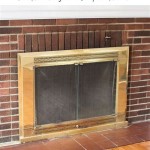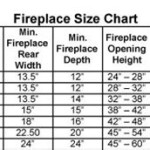The Enduring Appeal of Fireplace and Mantle: A Focal Point for the Home
The fireplace and mantle represent a significant architectural and design element in many homes. More than just a source of heat, the fireplace serves as a focal point, gathering space, and a reflection of personal style. From rustic stone hearths to sleek, modern designs, the variations in fireplace and mantle aesthetics offer endless possibilities for enhancing the ambiance and value of a dwelling.
Historically, the fireplace held a central role in daily life, providing essential warmth for cooking, heating, and social gatherings. As heating technology advanced, the fireplace evolved from a necessity to a cherished decorative feature. The mantle, initially a structural component to support the chimney breast, gradually transformed into a display area for prized possessions, family photographs, and seasonal decorations. The synthesis of the two elements – the functional fireplace and the decorative mantle – resulted in a powerful design statement that continues to resonate in contemporary interior design.
Understanding the Components of a Fireplace
A traditional fireplace comprises several key components. The firebox is the enclosed area where the fuel, be it wood, gas, or other materials, is burned. It is typically constructed from fire-resistant materials such as firebrick to withstand the intense heat generated during combustion. The flue, or chimney, serves as the exhaust system, safely channeling smoke and gases away from the living space. A damper, a movable plate within the flue, controls airflow, preventing heat loss when the fireplace is not in use and regulating the draft during operation. Hearth, the non-combustible area surrounding the firebox opening, provides a safe zone, protecting flooring and preventing sparks from causing fires.
Beyond these core components, various architectural features can further define the fireplace's aesthetic. Surrounds, crafted from materials like brick, stone, tile, or wood, frame the firebox opening, adding visual interest and complementing the overall design. Fireplace inserts, self-contained heating units that fit within existing fireboxes, offer enhanced efficiency and control. These inserts often feature glass doors to contain embers and improve heat distribution. The selection of each component and its materials greatly influences the fireplace's functionality, efficiency, and stylistic impact.
The Diverse Styles of Fireplace Mantles
Mantles, the decorative shelf above the fireplace opening, come in a vast array of styles and materials. Traditional mantles often feature elaborate carvings, ornate moldings, and classical architectural details, reflecting the elegance of bygone eras. These mantles are commonly crafted from hardwoods such as mahogany, cherry, or oak, and may be stained or painted to match the surrounding décor. In contrast, contemporary mantles tend to embrace minimalist designs, characterized by clean lines, geometric shapes, and the use of materials like concrete, metal, or glass. These modern mantles often prioritize functionality, providing a simple surface for displaying artwork or electronic devices.
Rustic mantles, intended to evoke a sense of natural warmth and authenticity, often incorporate reclaimed wood, rough-hewn timbers, or natural stone. These mantles may feature exposed knots, cracks, and other imperfections, adding character and visual interest. Farmhouse-style mantles share some similarities with rustic designs but often incorporate painted finishes, shiplap detailing, and vintage-inspired accents. The choice of mantle style should complement the overall architectural style of the home and reflect the homeowner's personal preferences.
Floating mantles represent a contemporary trend, offering a minimalist and visually striking alternative to traditional designs. These mantles appear to be suspended in mid-air, creating a sense of lightness and openness. They are typically constructed from solid wood or engineered wood products and are securely mounted to the wall using concealed brackets. Corner fireplaces provide a unique design challenge, requiring mantles that are specifically designed to fit the angled configuration. These mantles may feature curved lines, asymmetrical designs, and custom-built storage solutions to maximize space and functionality.
Factors to Consider When Choosing a Fireplace and Mantle
Selecting the right fireplace and mantle requires careful consideration of several factors. The size and layout of the room are paramount. A large, ornate fireplace may overwhelm a small space, while a small, understated design may be lost in a grand room. The architectural style of the home should also be taken into account. A modern fireplace may clash with a traditional Victorian home, while a rustic fireplace may feel out of place in a sleek, contemporary apartment. The intended use of the fireplace should also be considered. If the fireplace is primarily intended for heating, a high-efficiency model with a built-in fan may be the best choice. If the fireplace is primarily intended for aesthetic purposes, a decorative model with a visually striking design may be more appropriate.
Budgetary constraints are invariably a significant factor. Fireplaces and mantles range in price from relatively inexpensive prefabricated units to custom-built designs that can cost several thousand dollars. The materials used in the construction of the fireplace and mantle will also affect the overall cost. Stone and hardwood are generally more expensive than brick and engineered wood. Installation costs should also be factored into the budget. Installing a fireplace can be a complex and time-consuming task, and it is generally recommended to hire a qualified professional to ensure that the installation is done safely and correctly.
Safety considerations are of utmost importance. Fireplaces should be regularly inspected and maintained to ensure that they are functioning properly. Chimneys should be cleaned annually to remove creosote buildup, which can pose a fire hazard. Smoke detectors and carbon monoxide detectors should be installed in the vicinity of the fireplace to provide early warning of any potential problems. When selecting a fireplace, it is important to choose a model that is certified by a reputable testing agency, such as Underwriters Laboratories (UL) or the Canadian Standards Association (CSA). These certifications ensure that the fireplace has been tested for safety and performance.
Finally, personal preferences should guide the selection process. The fireplace and mantle should reflect the homeowner's individual style and taste. There are countless options to choose from, so it is important to take the time to research and explore different styles before making a decision. Visiting showrooms, browsing online catalogs, and consulting with design professionals can help to narrow down the options and find the perfect fireplace and mantle for the home.
In conclusion, the fireplace and mantle remain an enduring symbol of warmth, comfort, and style. By carefully considering the various factors outlined above, homeowners can select a fireplace and mantle that will enhance the enjoyment and value of their home for many years to come. The melding of function and aesthetics continues to make the fireplace and mantle a coveted feature in homes across diverse architectural styles and personal tastes.

Barnwood Fireplace Mantel The Collection

Fireplace Mantel 8 By 66 Long

Wood N Finish Fireplace Mantel Kit Walnut

Francis Fireplace Mantel Pottery Barn

Country Living 72 In W X 5 H 9 D White Wash Pine Hollow Farmhouse Fireplace Mantel The Mantels Department At Com

Modern Ember Lenwood Traditional Wood Fireplace Mantel Surround Kit Unfinished 56 Inch Opening Classic Design Tiered Frame Molding Com

Ellie Fireplace Mantel Pottery Barn

How To Select And Size Your Fireplace Mantel Water S Edge Woods Custom Wood

The Tactical Fireplace Mantle Traps

Fireplace Mantle Mantel Beam Floating Shelf Rustic Wooden Wood Shelving Farmhouse Decor Modern
Related Posts








